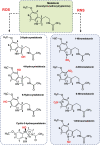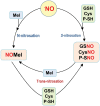Interactions of melatonin, reactive oxygen species, and nitric oxide during fruit ripening: an update and prospective view
- PMID: 35325926
- PMCID: PMC9523826
- DOI: 10.1093/jxb/erac128
Interactions of melatonin, reactive oxygen species, and nitric oxide during fruit ripening: an update and prospective view
Abstract
Fruit ripening is a physiological process that involves a complex network of signaling molecules that act as switches to activate or deactivate certain metabolic pathways at different levels, not only by regulating gene and protein expression but also through post-translational modifications of the involved proteins. Ethylene is the distinctive molecule that regulates the ripening of fruits, which can be classified as climacteric or non-climacteric according to whether or not, respectively, they are dependent on this phytohormone. However, in recent years it has been found that other molecules with signaling potential also exert regulatory roles, not only individually but also as a result of interactions among them. These observations imply the existence of mutual and hierarchical regulations that sometimes make it difficult to identify the initial triggering event. Among these 'new' molecules, hydrogen peroxide, nitric oxide, and melatonin have been highlighted as prominent. This review provides a comprehensive outline of the relevance of these molecules in the fruit ripening process and the complex network of the known interactions among them.
Keywords: Hydrogen peroxide; melatonin; nitric oxide; nitrosomelatonin; postharvest; ripening.
© The Author(s) 2022. Published by Oxford University Press on behalf of the Society for Experimental Biology.
Figures




Similar articles
-
Recent advancements in the mechanism of nitric oxide signaling associated with hydrogen sulfide and melatonin crosstalk during ethylene-induced fruit ripening in plants.Nitric Oxide. 2019 Jan 1;82:25-34. doi: 10.1016/j.niox.2018.11.003. Epub 2018 Nov 19. Nitric Oxide. 2019. PMID: 30465876 Review.
-
Melatonin: A master regulator of plant development and stress responses.J Integr Plant Biol. 2021 Jan;63(1):126-145. doi: 10.1111/jipb.12993. Epub 2020 Aug 22. J Integr Plant Biol. 2021. PMID: 32678945 Review.
-
Nitric oxide counters ethylene effects on ripening fruits.Plant Signal Behav. 2012 Apr;7(4):476-83. doi: 10.4161/psb.19523. Epub 2012 Apr 1. Plant Signal Behav. 2012. PMID: 22499176 Free PMC article. Review.
-
Nitric oxide in fruit ripening: trends and opportunities.Biotechnol Adv. 2010 Jul-Aug;28(4):489-99. doi: 10.1016/j.biotechadv.2010.03.001. Epub 2010 Mar 20. Biotechnol Adv. 2010. PMID: 20307642 Review.
-
Nitric oxide on/off in fruit ripening.Plant Biol (Stuttg). 2018 Sep;20(5):805-807. doi: 10.1111/plb.12852. Epub 2018 Jun 25. Plant Biol (Stuttg). 2018. PMID: 29869825 Review.
Cited by
-
Crosstalk between melatonin and reactive oxygen species in fruits and vegetables post-harvest preservation: An update.Front Nutr. 2023 Mar 3;10:1143511. doi: 10.3389/fnut.2023.1143511. eCollection 2023. Front Nutr. 2023. PMID: 36937352 Free PMC article. Review.
-
Exogenous Melatonin Spray Enhances Salinity Tolerance in Zizyphus Germplasm: A Brief Theory.Life (Basel). 2023 Feb 10;13(2):493. doi: 10.3390/life13020493. Life (Basel). 2023. PMID: 36836849 Free PMC article. Review.
-
Small Heat Shock Protein (sHSP) Gene Family from Sweet Pepper (Capsicum annuum L.) Fruits: Involvement in Ripening and Modulation by Nitric Oxide (NO).Plants (Basel). 2023 Jan 13;12(2):389. doi: 10.3390/plants12020389. Plants (Basel). 2023. PMID: 36679102 Free PMC article.
-
Melatonin Mitigates Cd-Induced Growth Repression and RNA m6A Hypermethylation by Triggering MMR-Mediated DNA Damage Response.Plants (Basel). 2025 May 6;14(9):1398. doi: 10.3390/plants14091398. Plants (Basel). 2025. PMID: 40364427 Free PMC article.
-
Ascorbate peroxidase in fruits and modulation of its activity by reactive species.J Exp Bot. 2024 May 3;75(9):2716-2732. doi: 10.1093/jxb/erae092. J Exp Bot. 2024. PMID: 38442039 Free PMC article. Review.
References
-
- Aghdam MS, Luo Z, Li L, Jannatizadeh A, Fard JR, Pirzad F.. 2020a. Melatonin treatment maintains nutraceutical properties of pomegranate fruits during cold storage. Food Chemistry 303, 125385. - PubMed
-
- Aghdam MS, Palma JM, Corpas FJ.. 2020b. NADPH as a quality footprinting in horticultural crops marketability. Trends in Food Science & Technology 103, 152–161.
-
- Airaki M, Sánchez-Moreno L, Leterrier M, Barroso JB, Palma JM, Corpas FJ.. 2011. Detection and quantification of S-nitrosoglutathione (GSNO) in pepper (Capsicum annuum L.) plant organs by LC-ES/MS. Plant & Cell Physiology 52, 2006–2015. - PubMed
Publication types
MeSH terms
Substances
Grants and funding
LinkOut - more resources
Full Text Sources

